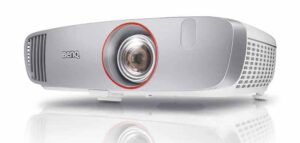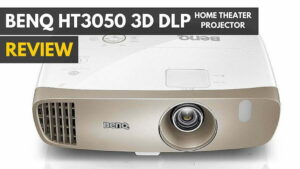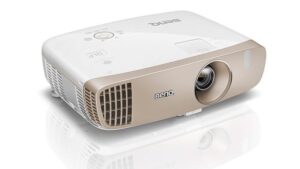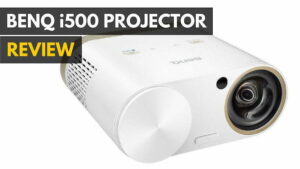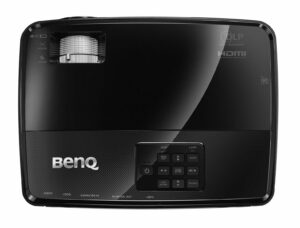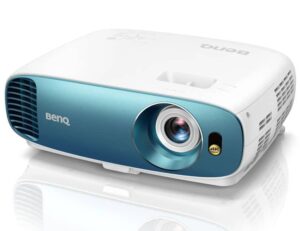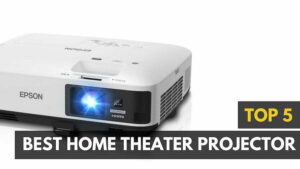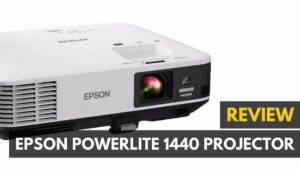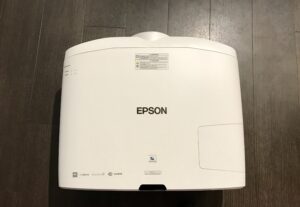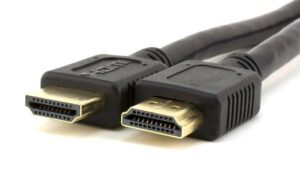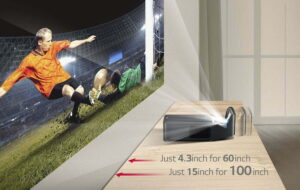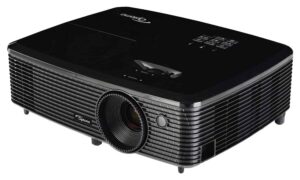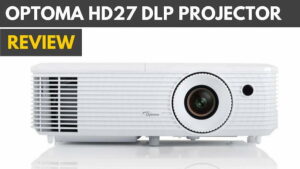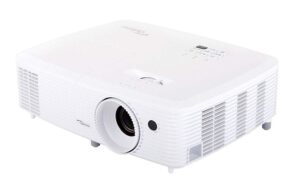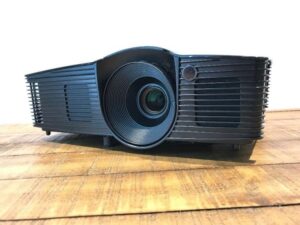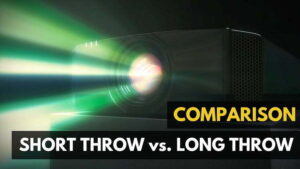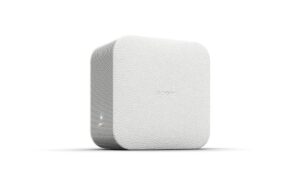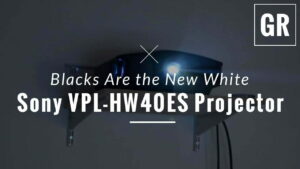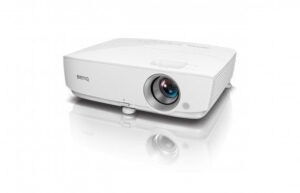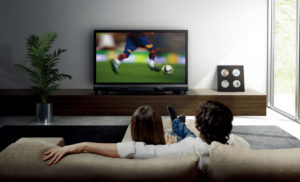For a long time, the only way to get a really big image at home was to have a front projector — TV sizes greater than 50-inches being scant and expensive. But since large flat-panel TVs are now plentiful and far from exorbitant, what’s the value of getting a projection system? The answer is to envelop the viewer in the big “movie theater” experience that was the hope to attain for home viewing in the first place. If you’re using this projector for a presentation, you might also find our Giffin stylus pen and laser pointer review useful. And BenQ’s W1500 Digital Projector Home Cinema Series not only fulfills this desire, but enhances the experience well beyond that of its competitors in the marketplace. You’ll also want to check out our best projector screen features to look out for article.
Our home theater projector reviews have all the info that you need to pick the right one for you.
The W1500 is compact in size and unremarkable in appearance. A wireless HDMI dongle (powered by USB) is provided to connect to the video source — cable box, Blu-ray player, etc. — and the Full HD 1080p signal is automatically routed to the W1500’s internal receiver. This makes using the projector on a table or any surface (as opposed to mounting it on a ceiling) less problematic since the only wiring needed is the power plug. Also falling into this category is the short-throw lens that enabled the projector to work at shorter distances from the screen (a 1.6X zoom being built-in). The basic setup for projection on the 90”+ 16:9 screen used had it placed on a table and aligned by raising the bottom legs and then using a level.
Turned on, a tone sounded and the bulb came up to full brightness well within two minutes. The internal color wheel requires avoiding bumps to the projector, so once I used the built-in vertical lens shift to “tighten” the image to the screen, I went to the remote exclusively which has all of the controls buttons necessary. This also included dedicated ones for such things as freezing the image and bringing up a test pattern for focus and alignment. There are both top and front-mounted IR receivers on the projector. If inputs are to be used instead of wireless, these consist of 2 HDMI, a Component, S-Video, Video, and D-Sub for a PC. There are also 10-watt internal speakers — a convenience but only marginally useful even with the mild hum that the projector makes in use.
Related: If you like what you have read so far, also check out our BENQ W1080ST review.
The W1500 has the usual Menu settings found in projectors (and TVs for that matter) such as brightness and contrast, etc., but adds to that with greater control over those settings as well as additional controls. For example, the pre-sets for the video image, such as Cinema, Dynamic, 3D, can all be tweaked for greater personal preference, besides 3 user modes that are totally for the user to create. I found that the default settings were fairly accurate and so made very minor changes — such as altering the color temperature when playing 3D. Some will find the ability to tweak “noise” through Noise reduction and Detail enhancement useful with streaming as well; personal preference being the issue here and the W1500 is much more accommodating to this than many other projectors I have seen. The Frame Interloping alone is worth the price of admission as it can smooth out imaging to make film content look quite superior, although care must be taken not to push it to where it gets the “soap opera” live TV look.
Since DLP projectors can cause “rainbow” issues, I approached viewing content on the W1500 from the point of view that if I didn’t see problems, they didn’t exist. And this was the case for me over the course of watching many hours of TV shows, movies on disc and streaming content. Short of suggesting that those watching try to be more dead-center to the image rather than at an acute angle, it does seem to be a case of where some people, though definitely, it’s a small number, will be better suited for going to an LCD projector instead (which of course brings in other issues such as lower contrast and lesser black levels).
I chose the Blu-ray of Season 4 of Downton Abbey because of the production’s attention to detail and concentrated on the clothing for both sharpness and color fidelity. The projector provided a uniformly bright view, with no fall off from edge to edge, with tack sharpness once I toned the contrast down slightly. The color was consistent with no banding effects and the flesh tones were natural and attractive to the eye — there wasn’t any color “bleeding” either. As to blacks, I’ve always found that this partly depends on the qualities of the projection screen as much as that of the projector, but playing across the Stewart Filmscreen, the level of black approached that of a flat panel with barely a trace of gray or loss of detail due to an “inkiness (true dense blacks weren’t to be had in this TV show). Although, you can compare the BenQ HT5550 VS Epson 5050UB to determine color consistency.
Related: Also check out our Bigasuo Projector review.
I also had the opportunity to watch an advance of the animated Cloudy With A Chance of Meatballs 2, which had both 2D and 3D versions available. The BenQ 3D active glasses functioned efficiently and other than a discernible loss of brightness (necessary evil when playing 3D), the view had no motion artifact issues or colors being muted — a tweak of contrast took care of enhancing the brightness of the overall image, as did bringing up the Brilliant Color option. The overall animation was bright and colorful and definitely more dynamic in 3D than in 2D — the higher level of definition being outputted by the projector added to the enjoyment since it helped to keep the onscreen objects from “blurring” together during fast-motion sequences. If you want better 3D detail, you’ll need to check out the BenQ HT3050 3D DLP home theater projector.
During the course of using the W1500, I passed back and forth between using a wired HDMI and a wireless connection — wired of course there were no issues in having a stable connection and the results, as noted above, were very good. Using the wireless was a bit more hit and miss — partly a result I think of the small size of the transmitter (when compared to the large stand-alone transmitter/receiver HDMI wireless kits on the market). So while the distance of 20 feet that was used between the video source and the W1500 didn’t result in the signal being lost, sometimes the quality of the transmitted image failed and resulted in blocky pixels, motion artifact visuals, and a “mushy” resolution for a few seconds now and then. The takeaway here was that wireless, even using the 5GHz band, is not always the answer and should be used only when not having a wired connection is the only alternative (that or having a larger, more powerful transmitter).
Bottom line: The BenQ W1500 Digital Projector Home Cinema Series is a well-crafted DLP projector. The $1,599.00 retail doesn’t cover just a quality projection of images in 2D and 3D, but also sensible and useful setting adjustments and the ability to cut the cord for connecting to the video source. Those looking for a big image with minimal maintenance of the means for viewing same will find the W1500 a great value. Yet, if $1,500+ is too much to drop on a projector, you’ll want to check out the Epson home cinema 1060 review.
Read Next: Best Projector Screen Review
Related Articles:
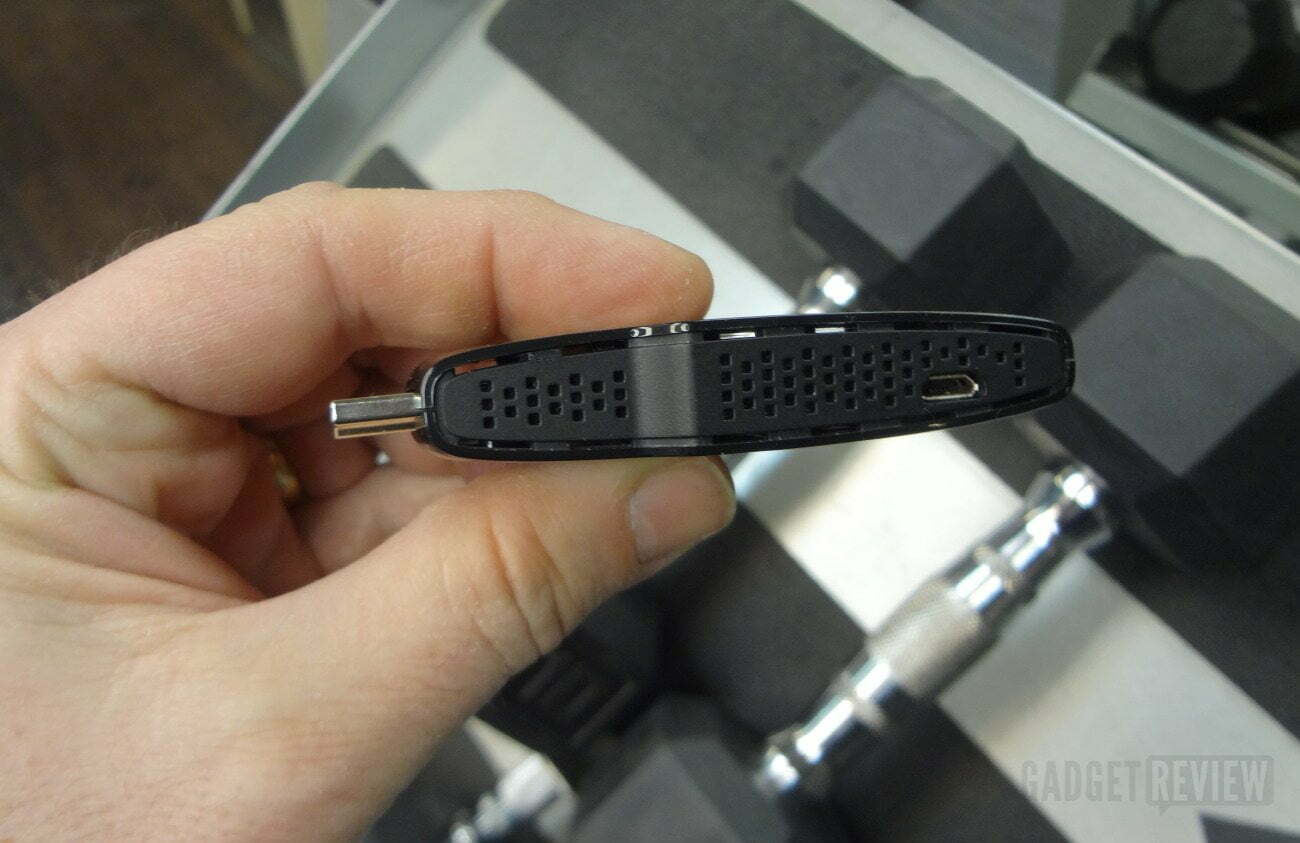
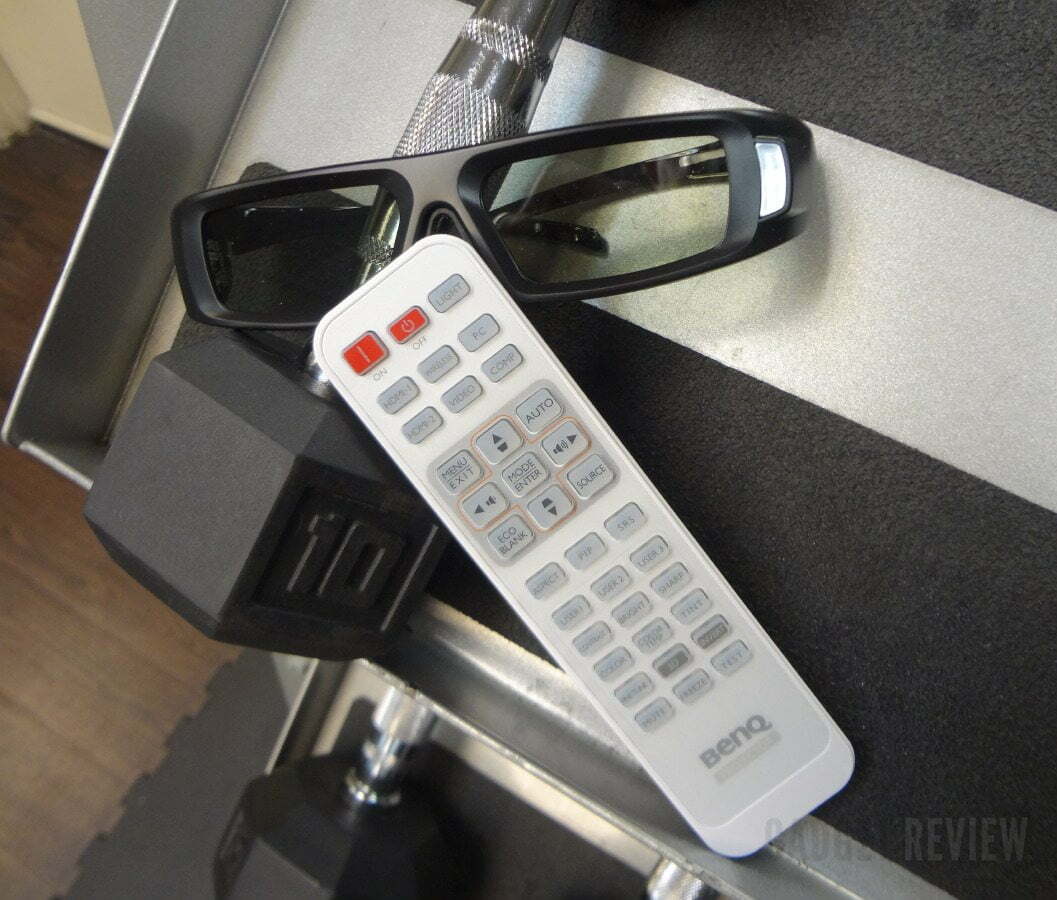
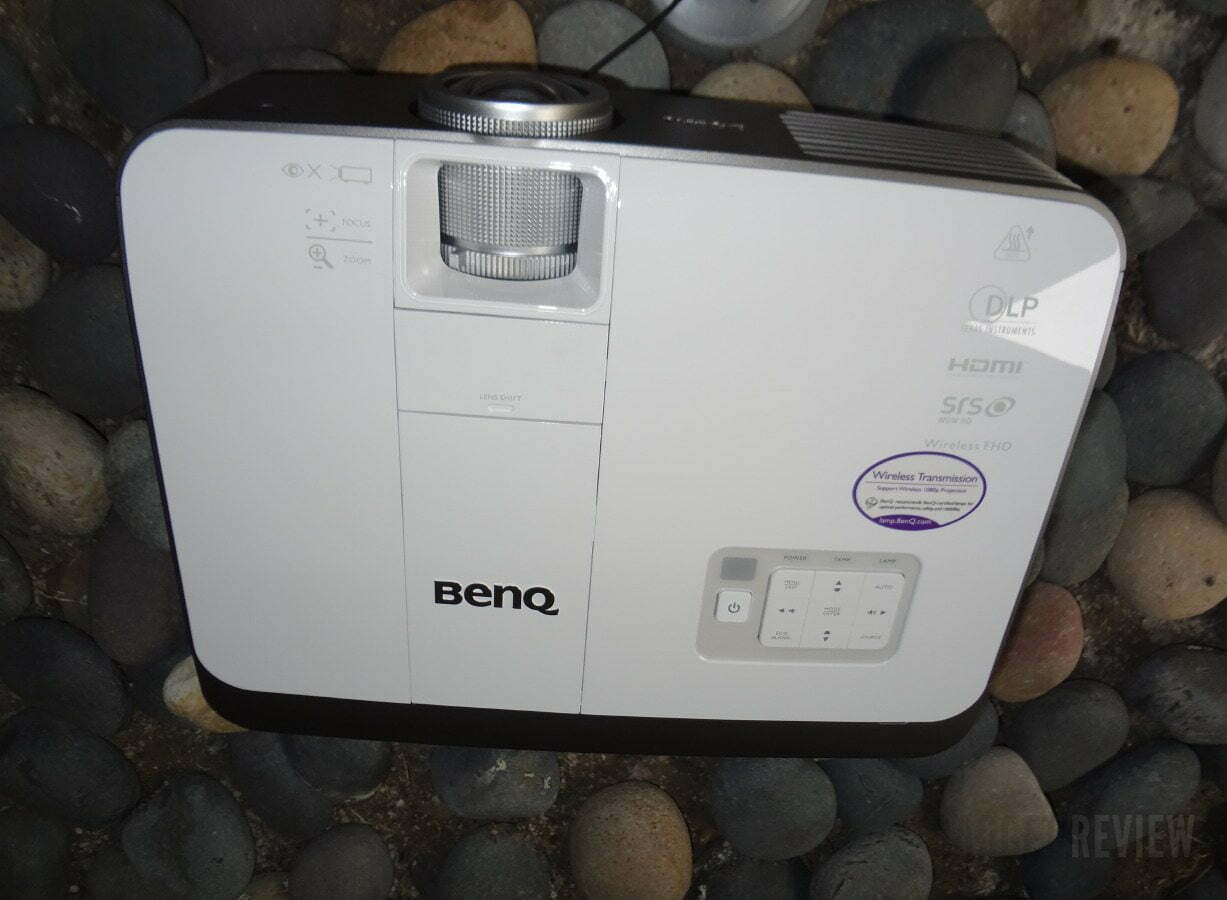
![10 Best iPhone Projector in [year] 1 best iphone projector](https://www.gadgetreview.dev/wp-content/uploads/best-iphone-projector-image-300x225.jpg)
![10 Best Laser Projectors in [year] 2 Best Laser Projector|Optoma UHZ65 Laser Projector](https://www.gadgetreview.dev/wp-content/uploads/best-laser-projector-300x180.jpg)
![10 Best Long Throw Projectors in [year] 3 Best Long Throw Projector](https://www.gadgetreview.dev/wp-content/uploads/best-long-throw-projector-300x145.jpg)
![10 Best Outdoor Projectors in [year] 4 Best Outdoor Projector](https://www.gadgetreview.dev/wp-content/uploads/best-outdoor-projector-300x226.jpg)
![10 Best Short Throw Projectors in [year] 5 best short throw projector](https://www.gadgetreview.dev/wp-content/uploads/best-short-throw-projector-image-300x200.jpg)
